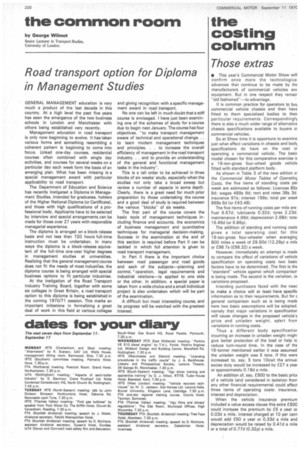the costing column
Page 198

If you've noticed an error in this article please click here to report it so we can fix it.
Those extras
• This year's Commercial Motor Show will confirm once more the technologica advances that continue to be made by the manufacturers of commercial vehicles anc equipment. But in one respect they rernair "old fashioned"--to advantage.
It is common practice for operators to buy commercial vehicle chassis and then have fitted to them specialized bodies to theii particular requirements. Correspondingly there is also a much wider range of alternative chassis specifications available to buyers 01 commercial vehicles.
So at Show time it is opportune to examine just what effect variations in chassis and body specifications do have on the cost 01 operating a commercial vehicle. The basic model chosen for this comparative exercise is a 16-ton-gross four-wheel goods vehicle fitted with standard platform body.
As shown in Table 3 of the new edition 01 the Commercial Motor Tables of Operating Costs, the five items of standing costs pei week are estimated as follows: Licences 855 9d; wages 489s 6d; rent and rates 38s 3d; insurance 97s; interest 159s; total per week 869s 6d (or £43.48).
The five items of running costs per mile are. Fuel 6.57d; lubricants 0.32d; tyres 2.23d; maintenance 4.66d; depreciation 2.68d; total 16.46d (or 6.86p).
The addition of standing and running costs gives a total operating cost for this 16-ton-gross four-wheeler when averaging 800 miles a week of 29.50d (12.29p) a mile or £98 7s (£98.32) a week.
However, immediately an attempt is made to compare the effect of variations of vehicle specification on operating costs two basic factors have to be determined. The first is the "standard" vehicle against which comparisor is being made. The second is the variation, or variations proposed.
lntending purchasers faced with the neec to make a choice will at least have specific information as to their requirements. But for e general comparison such as is tieing made here two basic assumptions will be adopted, namely that major variations in specification wilt cause changes in the proposed vehicle's price and unladen weight, arrart fronvariations in running costs.
Thus a different body specificatior incurring an increase in unladen weight mighi give better protection of the load or help tc reduce turn-round time. In the case of thE 16-tonner mentioned earlier it was assumed the unladen weight was 5 tons. If this were increased to, say, 5 tons lOcwt the annual excise duty would be increased by £27 a year or approximately 0.18d a mile.
An addition of, say, £500 to the basic pric of a vehicle land considered in isolation from any other financial requirements) could affect three items of operating costs: insurance, interest and depreciation.
When the vehicle insurance premium included a value excess clause this extra £500 could increase the premium by £5 a year or 0.03d a mile. Interest charged at 10 per cent would add £50 a year or 0.33d a mile and depreciation would be raised by 0.41d a mile or a total of 0.77d (0.32p) a mile.




















































































































































































































































